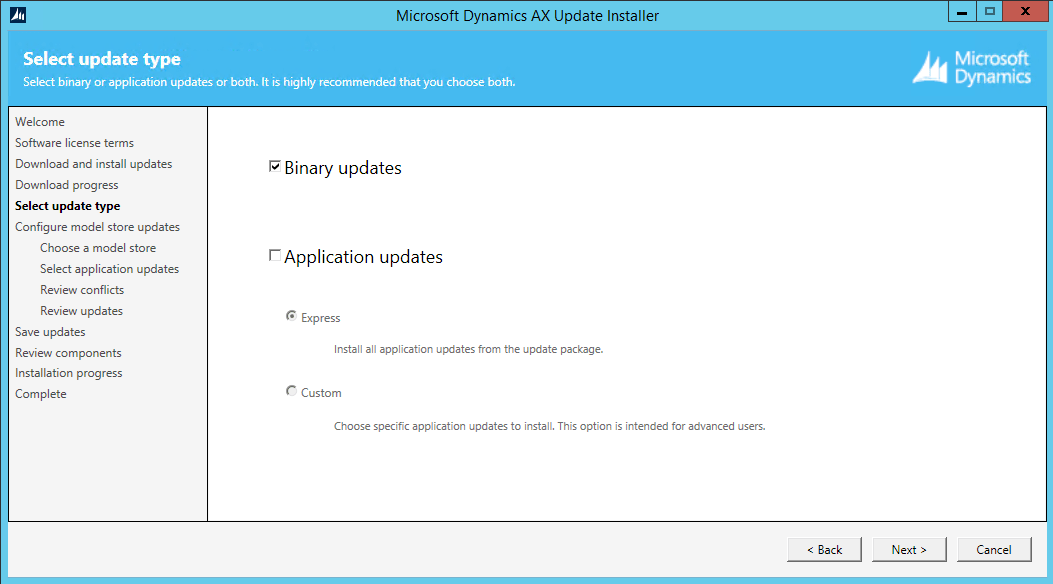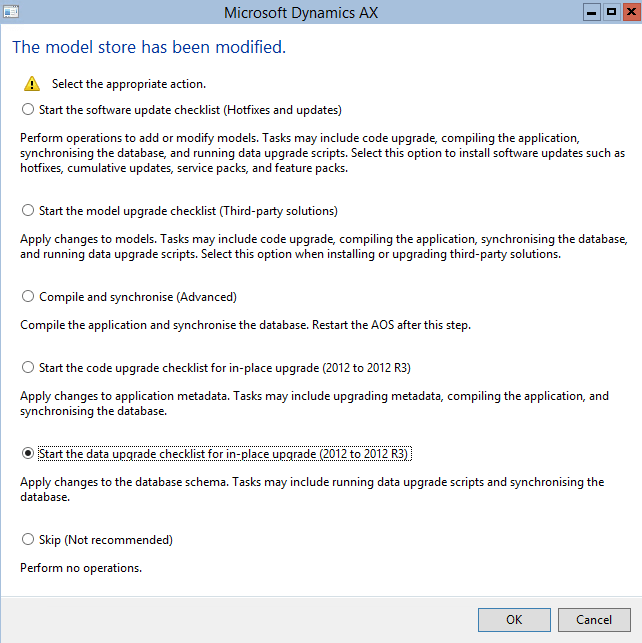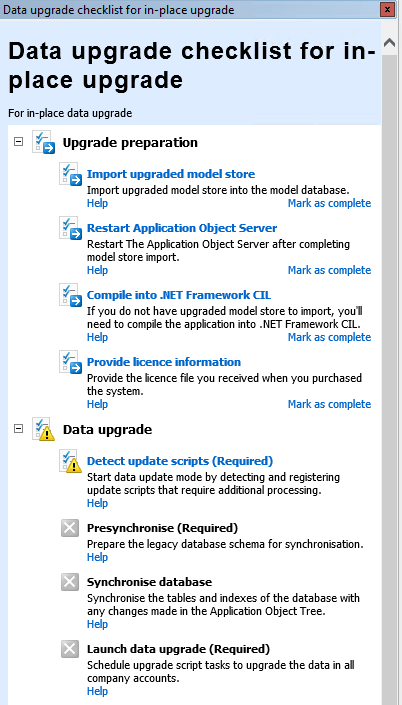This is a continuation of the cumulative updates installation guide. In this part I will focus on installing updates on a Live environment.
Introduction
The general process can be divided into these main points:
- Prepare Upgrade environment - please go to Pre-installation list.
- Install CU9 on Upgrade environment.
a. Run upgrade process and install kernel only - please go to Update install list.
b. Install modelStore file prepared in previous part - please go to Post installation - data upgrade (Upgrade) list. - Propagate changes to Live environment.
a. Run upgrade process and install kernel only - please go to Update install list.
b. Copy databases from Upgrade to Live SQL servers - please go to Upgrade Live environments (Live) list.
c. Run post-upgrade operations - please go to Post upgrade list.
The reason I suggest using Upgrade environment is to have as little operation directly on Live as possible. This allows us to have the option to stop the process if we encounter any issues in installing updates on the Upgrade environment.
Pre-installation
Step 1
Copy upgrade files to Upgrade environment - be sure that we are using the same update package file.
Step 2
Backup data and modelstore databases of Live environment.
Step 3
Restore Upgrade databases with the backups.
- Live data database into Upgrade data database environment.
- Live modelstore database into Upgrade modelstore database environment.
Step 4
If you need to enable some additional configuration keys please do it on Upgrade environment after restoring live databases.
Step 5
For CU8, install Report Viewer 2012 RunTime in case it is not already installed as this is a prerequisite to install AOS, Client, Components, Set up and Support files.
Download from http://www.microsoft.com/en-us/download/details.aspx?id=35747.
Step 6
For CU8, uninstall Visual Studio 2010 Tools from AX server if it is installed.
Step 7
Prepare Upgrade shortcut to use for upgrade process - this shortcut should be used for the whole process to connect to Dynamics AX during upgrade:

Step 8
Stop Upgrade AOS.
Installing update
Step 1
Stop AOS.
Step 2
Start C:\CU9 setup\axupdate.exe.
Step 3
Click Next.
Step 4
Click Accept and continue.
Step 5
Select Install updates and browse to file package file.

Step 6
Select only Binary update.

Step 7
Components:

- If installing on AOS server, be sure that Application Object Server (AOS) is checked.
- If installing on client, be sure that Client and Office add-ins is checked.
- No other options are mandatory.
Step 8
Select Install updates on this computer. Click Next.
Step 9
Click finish.
Post installation - data update
Be sure to use the correct shortcut to connect to Dynamics AX. This is to properly prepare data database to be imported to Live. This way we are sure to work on Upgrade environment and modify Live only at the latest stage of the process.
Step 1
Stop AOS.
Step 2
Remove all files in XppIL folder (Upgrade).
Step 3
Use modelStore file (from part1) to deploy to Upgrade environment:
- Run command prompt – in run/search field write cmd.
- Write cd <path to AX your server folder> for example: cd “C:\Program Files\Microsoft Dynamics AX\60\Server\MicrosoftDynamicsAX\bin”.
- Write AXUtil schema /schemaname:TransferSchema
- Write AXUtil importstore /file:C:\Users\administrator\Documents\ upgradeCU9.axmodelstore /schemaname:TransferSchema
- If you have not stopped AOS then write Net stop AOS60$01
- Write AXUtil importstore /apply:TransferSchema /backupschema:dbo_backup
- Write AXUtil schema /drop:TransferSchema
- Write AXUtil schema /drop:dbo_backup
Step 4
Start AOS - it will take some time because of recreating files in XppIL folder.
Step 5
Assign DataUpdate batch group to server.
Step 6
Here you can use one of two options:
- If the upgrade window pops up when the Dynamics AX client starts:

- If window from point a. doesn’t popup, then run Class -> SysModelStoreModified and proceed with point a.
- Start “Data update checklist”: AOT -> Menu Items -> Display -> SysCheckList_Update.
In both options you will get “Data upgrade checklist”:

Because we did modelStore deployment we can click “Mark as complete” on all 4 points in “Upgrade preparation” group.
- Continue with Data upgrade checklist.
Step 7
After the upgrade, if the upgrade window pops up when the Dynamics AX client starts, please follow these steps:

- Select first option “Start the software update checklist” or “Start the data upgrade checklist for in-place upgrade”
- Follow checklist clicking “Mark as complete” whenever you can. Because we already did everything from the data update checklist these steps are only to stop the popup window showing.
Step 8
Stop AOS.
Step 9
Backup data and modelstore databases from Upgrade environment - they will be used to restore Live.
Upgrade Live environments (Live)
Step 1
Stop Live AOS’s.
Step 2
For each Live AOS:
- Remove all objects from XppIL folder.
- Upgrade kernel - repeat steps from Installing update.
Step 3
Restore Live data and modelstore databases from Upgrade environment.
Step 4
Start AOS’s – it will take some time because of recreating files in XppIL folder.
Post upgrade
Step 1
For reports in Dynamics AX 2012 R3 CU8 to be working correctly be sure to:
- Update report viewer on the sql server.
- Create client config file and save in report server bin folder: https://technet.microsoft.com/EN-US/library/hh389774.aspx.
- Restart SSRS service.
Step 2
Deploy all reports.
Step 3
Upgrade all clients connecting to Live environment - repeat steps from Installing update.

